Moral Panic Theory Application 2022
VerifiedAdded on 2022/09/26
|7
|1506
|30
AI Summary
Contribute Materials
Your contribution can guide someone’s learning journey. Share your
documents today.
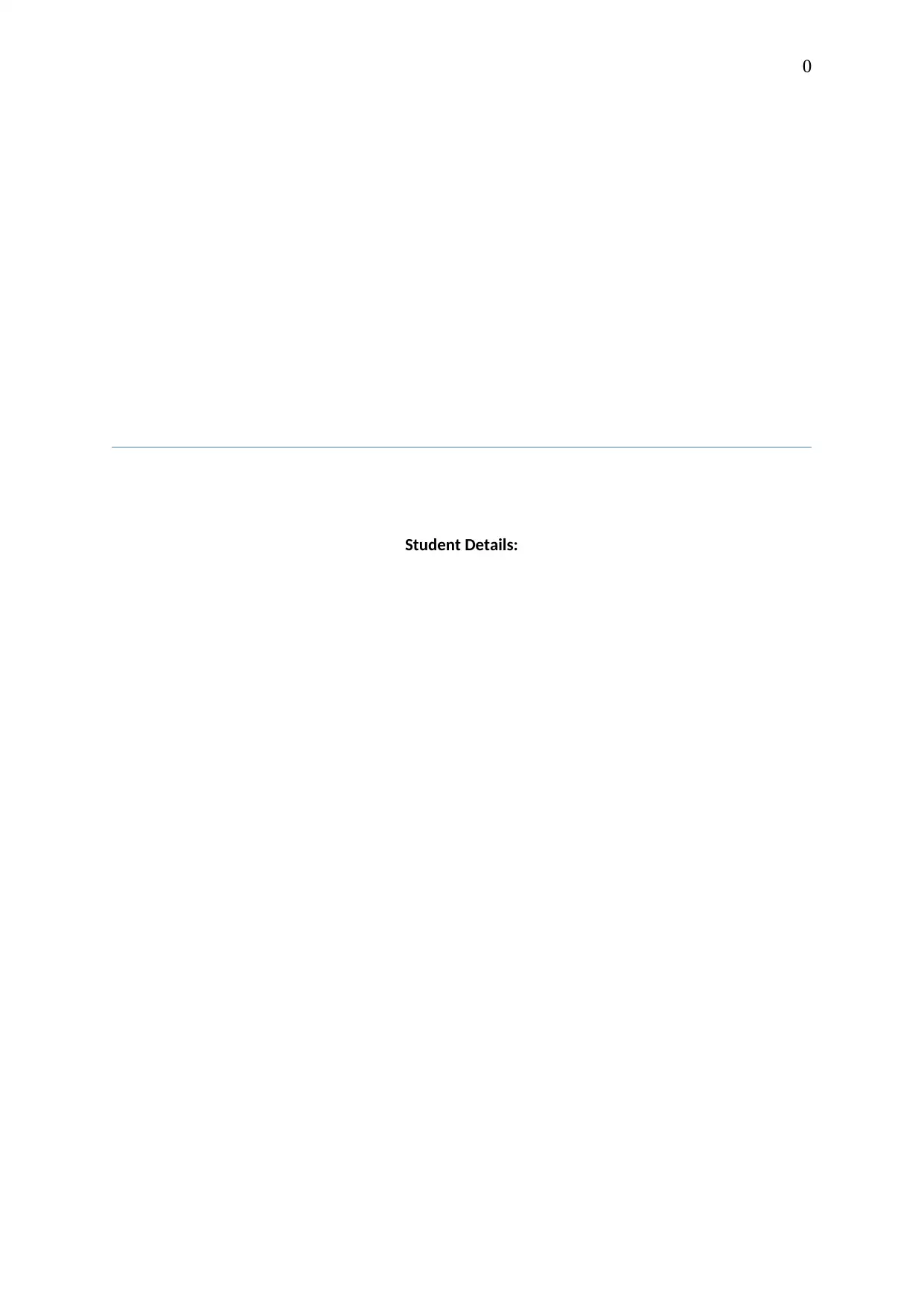
0
Student Details:
Student Details:
Secure Best Marks with AI Grader
Need help grading? Try our AI Grader for instant feedback on your assignments.
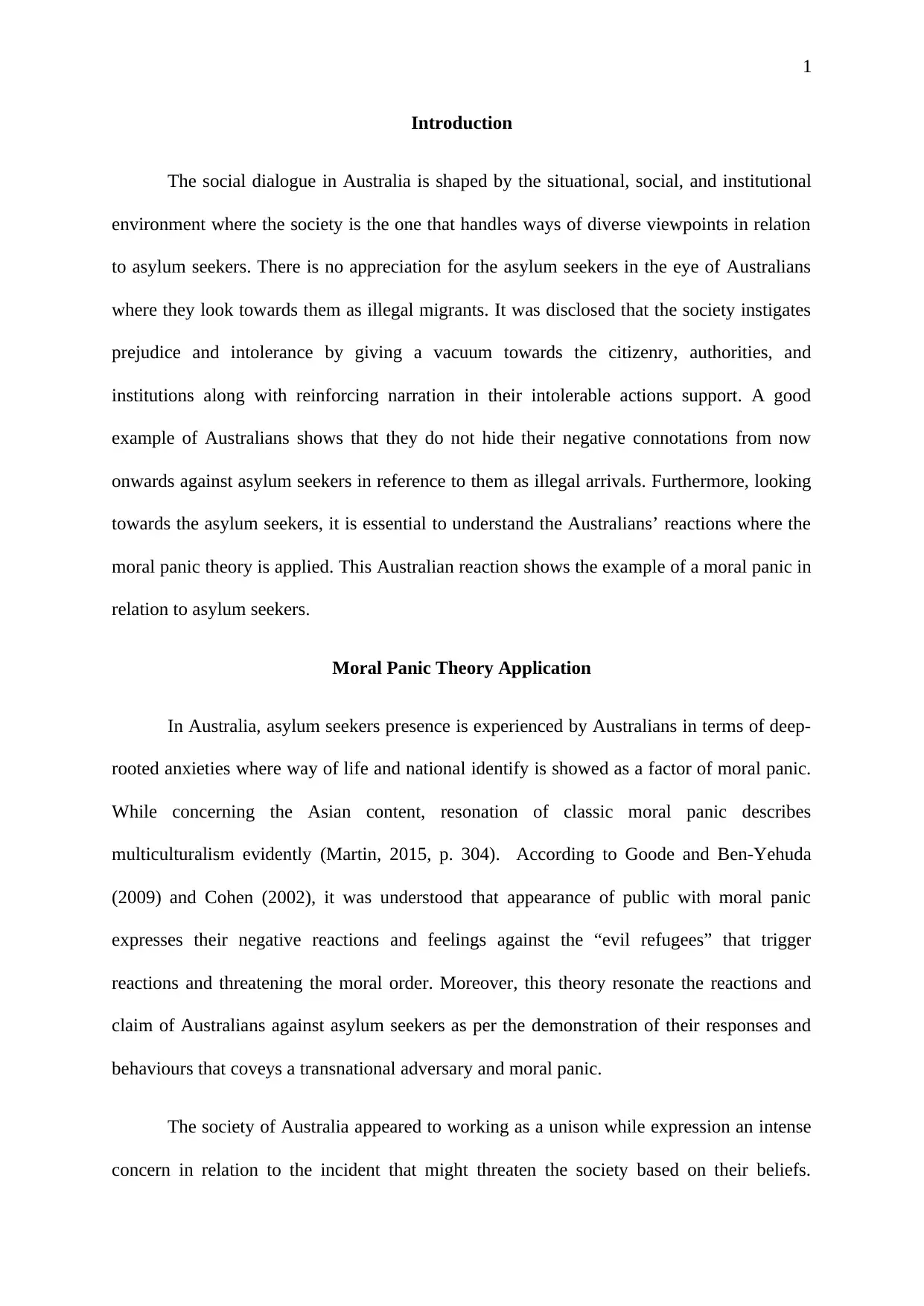
1
Introduction
The social dialogue in Australia is shaped by the situational, social, and institutional
environment where the society is the one that handles ways of diverse viewpoints in relation
to asylum seekers. There is no appreciation for the asylum seekers in the eye of Australians
where they look towards them as illegal migrants. It was disclosed that the society instigates
prejudice and intolerance by giving a vacuum towards the citizenry, authorities, and
institutions along with reinforcing narration in their intolerable actions support. A good
example of Australians shows that they do not hide their negative connotations from now
onwards against asylum seekers in reference to them as illegal arrivals. Furthermore, looking
towards the asylum seekers, it is essential to understand the Australians’ reactions where the
moral panic theory is applied. This Australian reaction shows the example of a moral panic in
relation to asylum seekers.
Moral Panic Theory Application
In Australia, asylum seekers presence is experienced by Australians in terms of deep-
rooted anxieties where way of life and national identify is showed as a factor of moral panic.
While concerning the Asian content, resonation of classic moral panic describes
multiculturalism evidently (Martin, 2015, p. 304). According to Goode and Ben-Yehuda
(2009) and Cohen (2002), it was understood that appearance of public with moral panic
expresses their negative reactions and feelings against the “evil refugees” that trigger
reactions and threatening the moral order. Moreover, this theory resonate the reactions and
claim of Australians against asylum seekers as per the demonstration of their responses and
behaviours that coveys a transnational adversary and moral panic.
The society of Australia appeared to working as a unison while expression an intense
concern in relation to the incident that might threaten the society based on their beliefs.
Introduction
The social dialogue in Australia is shaped by the situational, social, and institutional
environment where the society is the one that handles ways of diverse viewpoints in relation
to asylum seekers. There is no appreciation for the asylum seekers in the eye of Australians
where they look towards them as illegal migrants. It was disclosed that the society instigates
prejudice and intolerance by giving a vacuum towards the citizenry, authorities, and
institutions along with reinforcing narration in their intolerable actions support. A good
example of Australians shows that they do not hide their negative connotations from now
onwards against asylum seekers in reference to them as illegal arrivals. Furthermore, looking
towards the asylum seekers, it is essential to understand the Australians’ reactions where the
moral panic theory is applied. This Australian reaction shows the example of a moral panic in
relation to asylum seekers.
Moral Panic Theory Application
In Australia, asylum seekers presence is experienced by Australians in terms of deep-
rooted anxieties where way of life and national identify is showed as a factor of moral panic.
While concerning the Asian content, resonation of classic moral panic describes
multiculturalism evidently (Martin, 2015, p. 304). According to Goode and Ben-Yehuda
(2009) and Cohen (2002), it was understood that appearance of public with moral panic
expresses their negative reactions and feelings against the “evil refugees” that trigger
reactions and threatening the moral order. Moreover, this theory resonate the reactions and
claim of Australians against asylum seekers as per the demonstration of their responses and
behaviours that coveys a transnational adversary and moral panic.
The society of Australia appeared to working as a unison while expression an intense
concern in relation to the incident that might threaten the society based on their beliefs.
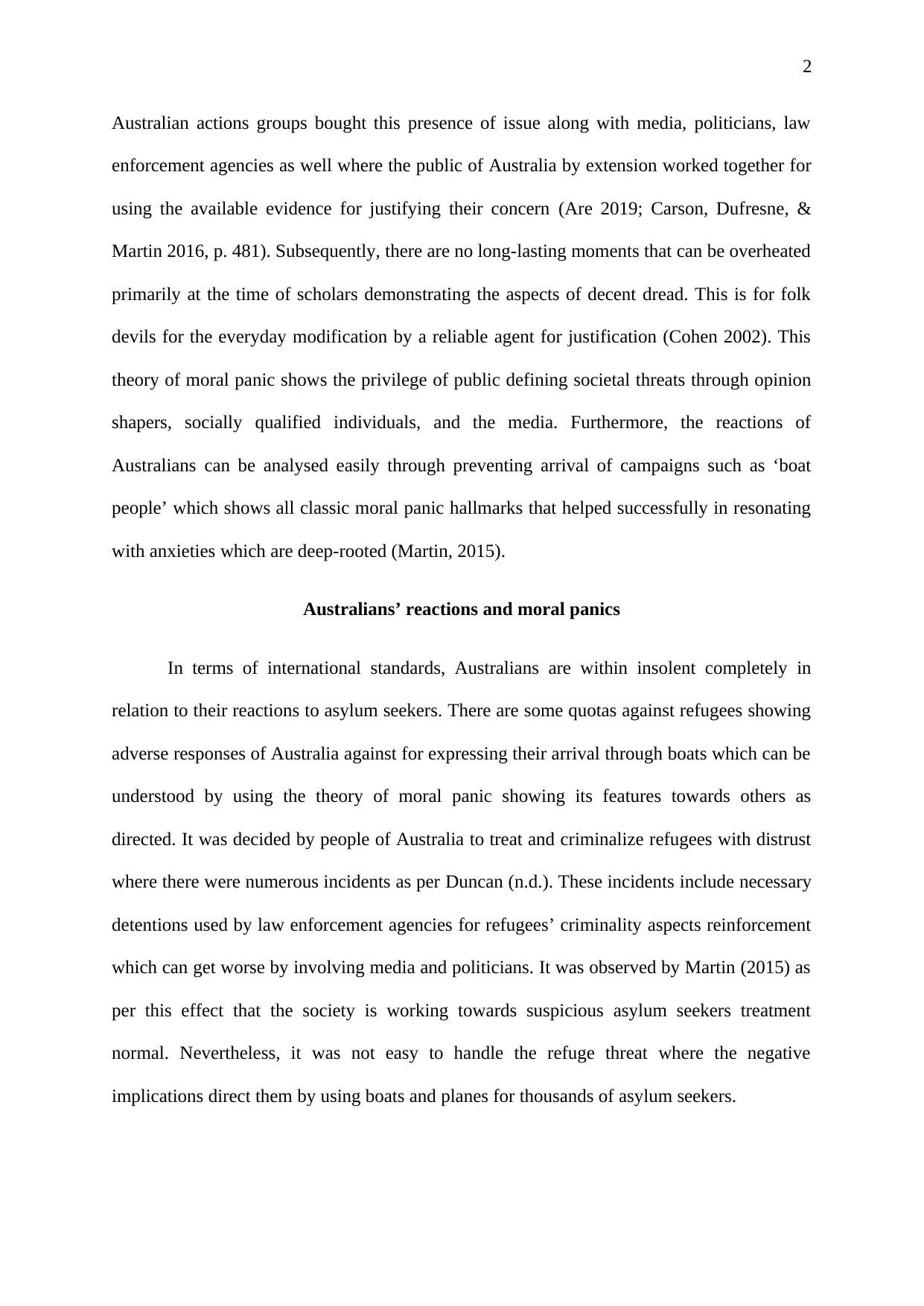
2
Australian actions groups bought this presence of issue along with media, politicians, law
enforcement agencies as well where the public of Australia by extension worked together for
using the available evidence for justifying their concern (Are 2019; Carson, Dufresne, &
Martin 2016, p. 481). Subsequently, there are no long-lasting moments that can be overheated
primarily at the time of scholars demonstrating the aspects of decent dread. This is for folk
devils for the everyday modification by a reliable agent for justification (Cohen 2002). This
theory of moral panic shows the privilege of public defining societal threats through opinion
shapers, socially qualified individuals, and the media. Furthermore, the reactions of
Australians can be analysed easily through preventing arrival of campaigns such as ‘boat
people’ which shows all classic moral panic hallmarks that helped successfully in resonating
with anxieties which are deep-rooted (Martin, 2015).
Australians’ reactions and moral panics
In terms of international standards, Australians are within insolent completely in
relation to their reactions to asylum seekers. There are some quotas against refugees showing
adverse responses of Australia against for expressing their arrival through boats which can be
understood by using the theory of moral panic showing its features towards others as
directed. It was decided by people of Australia to treat and criminalize refugees with distrust
where there were numerous incidents as per Duncan (n.d.). These incidents include necessary
detentions used by law enforcement agencies for refugees’ criminality aspects reinforcement
which can get worse by involving media and politicians. It was observed by Martin (2015) as
per this effect that the society is working towards suspicious asylum seekers treatment
normal. Nevertheless, it was not easy to handle the refuge threat where the negative
implications direct them by using boats and planes for thousands of asylum seekers.
Australian actions groups bought this presence of issue along with media, politicians, law
enforcement agencies as well where the public of Australia by extension worked together for
using the available evidence for justifying their concern (Are 2019; Carson, Dufresne, &
Martin 2016, p. 481). Subsequently, there are no long-lasting moments that can be overheated
primarily at the time of scholars demonstrating the aspects of decent dread. This is for folk
devils for the everyday modification by a reliable agent for justification (Cohen 2002). This
theory of moral panic shows the privilege of public defining societal threats through opinion
shapers, socially qualified individuals, and the media. Furthermore, the reactions of
Australians can be analysed easily through preventing arrival of campaigns such as ‘boat
people’ which shows all classic moral panic hallmarks that helped successfully in resonating
with anxieties which are deep-rooted (Martin, 2015).
Australians’ reactions and moral panics
In terms of international standards, Australians are within insolent completely in
relation to their reactions to asylum seekers. There are some quotas against refugees showing
adverse responses of Australia against for expressing their arrival through boats which can be
understood by using the theory of moral panic showing its features towards others as
directed. It was decided by people of Australia to treat and criminalize refugees with distrust
where there were numerous incidents as per Duncan (n.d.). These incidents include necessary
detentions used by law enforcement agencies for refugees’ criminality aspects reinforcement
which can get worse by involving media and politicians. It was observed by Martin (2015) as
per this effect that the society is working towards suspicious asylum seekers treatment
normal. Nevertheless, it was not easy to handle the refuge threat where the negative
implications direct them by using boats and planes for thousands of asylum seekers.
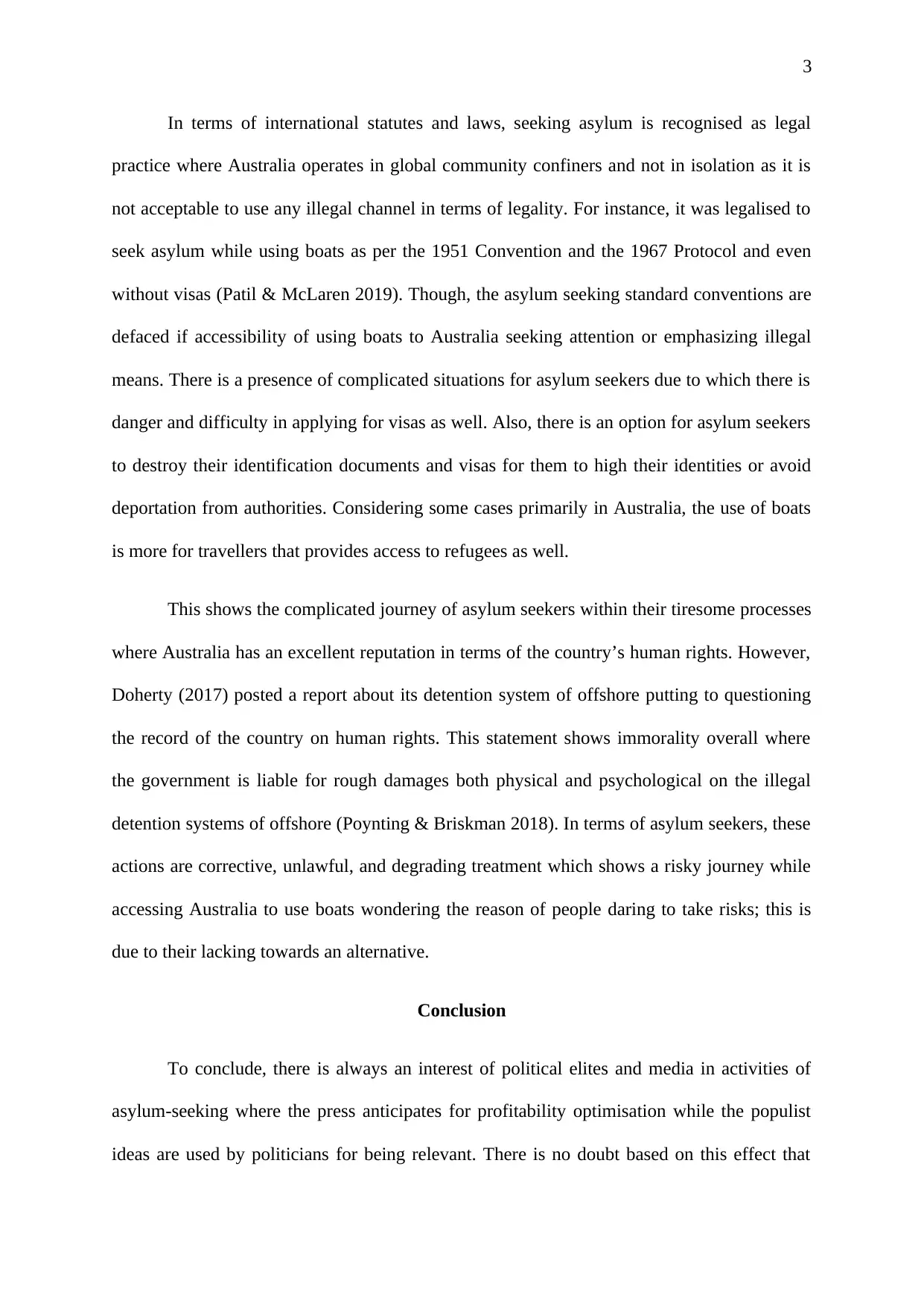
3
In terms of international statutes and laws, seeking asylum is recognised as legal
practice where Australia operates in global community confiners and not in isolation as it is
not acceptable to use any illegal channel in terms of legality. For instance, it was legalised to
seek asylum while using boats as per the 1951 Convention and the 1967 Protocol and even
without visas (Patil & McLaren 2019). Though, the asylum seeking standard conventions are
defaced if accessibility of using boats to Australia seeking attention or emphasizing illegal
means. There is a presence of complicated situations for asylum seekers due to which there is
danger and difficulty in applying for visas as well. Also, there is an option for asylum seekers
to destroy their identification documents and visas for them to high their identities or avoid
deportation from authorities. Considering some cases primarily in Australia, the use of boats
is more for travellers that provides access to refugees as well.
This shows the complicated journey of asylum seekers within their tiresome processes
where Australia has an excellent reputation in terms of the country’s human rights. However,
Doherty (2017) posted a report about its detention system of offshore putting to questioning
the record of the country on human rights. This statement shows immorality overall where
the government is liable for rough damages both physical and psychological on the illegal
detention systems of offshore (Poynting & Briskman 2018). In terms of asylum seekers, these
actions are corrective, unlawful, and degrading treatment which shows a risky journey while
accessing Australia to use boats wondering the reason of people daring to take risks; this is
due to their lacking towards an alternative.
Conclusion
To conclude, there is always an interest of political elites and media in activities of
asylum-seeking where the press anticipates for profitability optimisation while the populist
ideas are used by politicians for being relevant. There is no doubt based on this effect that
In terms of international statutes and laws, seeking asylum is recognised as legal
practice where Australia operates in global community confiners and not in isolation as it is
not acceptable to use any illegal channel in terms of legality. For instance, it was legalised to
seek asylum while using boats as per the 1951 Convention and the 1967 Protocol and even
without visas (Patil & McLaren 2019). Though, the asylum seeking standard conventions are
defaced if accessibility of using boats to Australia seeking attention or emphasizing illegal
means. There is a presence of complicated situations for asylum seekers due to which there is
danger and difficulty in applying for visas as well. Also, there is an option for asylum seekers
to destroy their identification documents and visas for them to high their identities or avoid
deportation from authorities. Considering some cases primarily in Australia, the use of boats
is more for travellers that provides access to refugees as well.
This shows the complicated journey of asylum seekers within their tiresome processes
where Australia has an excellent reputation in terms of the country’s human rights. However,
Doherty (2017) posted a report about its detention system of offshore putting to questioning
the record of the country on human rights. This statement shows immorality overall where
the government is liable for rough damages both physical and psychological on the illegal
detention systems of offshore (Poynting & Briskman 2018). In terms of asylum seekers, these
actions are corrective, unlawful, and degrading treatment which shows a risky journey while
accessing Australia to use boats wondering the reason of people daring to take risks; this is
due to their lacking towards an alternative.
Conclusion
To conclude, there is always an interest of political elites and media in activities of
asylum-seeking where the press anticipates for profitability optimisation while the populist
ideas are used by politicians for being relevant. There is no doubt based on this effect that
Secure Best Marks with AI Grader
Need help grading? Try our AI Grader for instant feedback on your assignments.
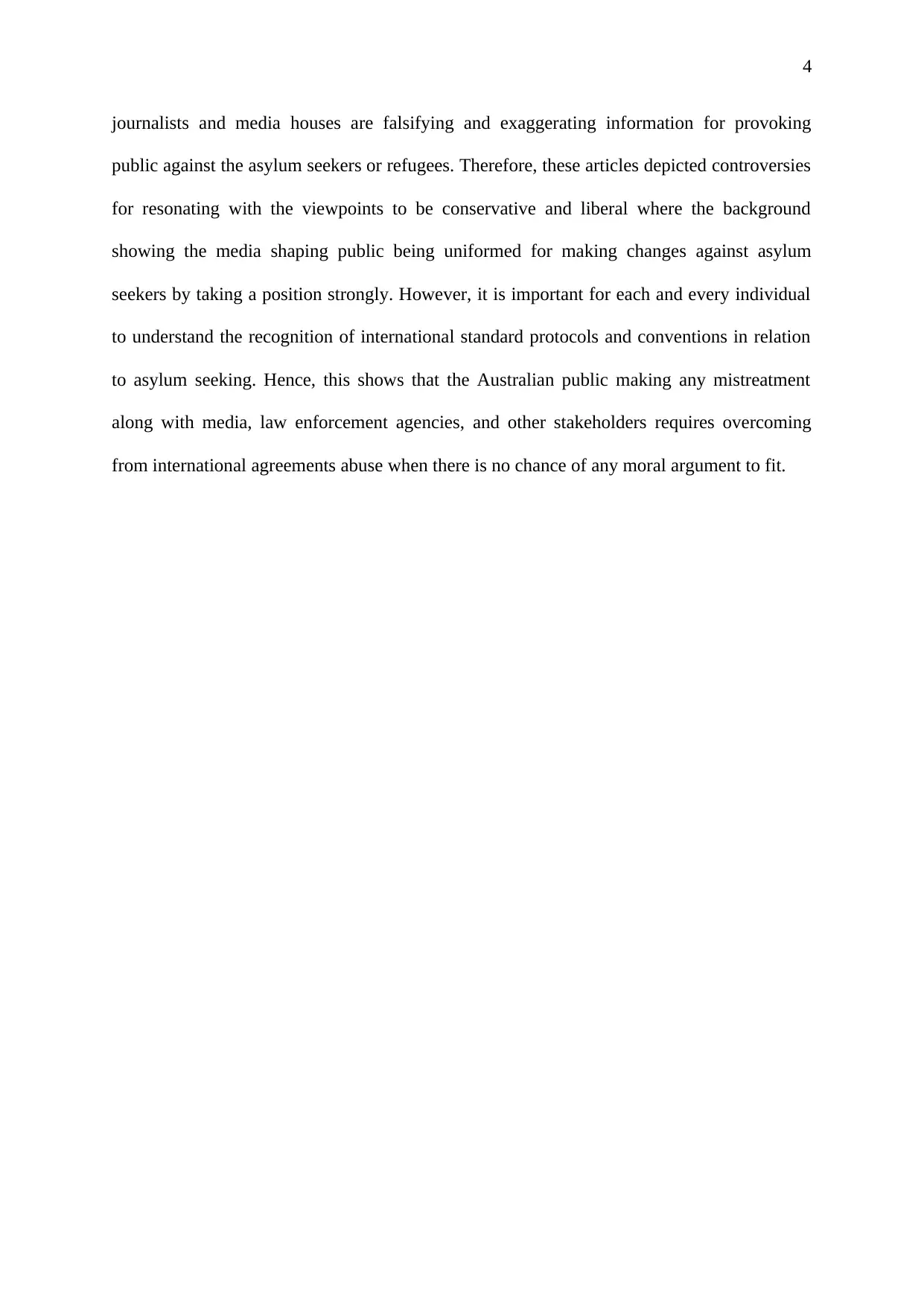
4
journalists and media houses are falsifying and exaggerating information for provoking
public against the asylum seekers or refugees. Therefore, these articles depicted controversies
for resonating with the viewpoints to be conservative and liberal where the background
showing the media shaping public being uniformed for making changes against asylum
seekers by taking a position strongly. However, it is important for each and every individual
to understand the recognition of international standard protocols and conventions in relation
to asylum seeking. Hence, this shows that the Australian public making any mistreatment
along with media, law enforcement agencies, and other stakeholders requires overcoming
from international agreements abuse when there is no chance of any moral argument to fit.
journalists and media houses are falsifying and exaggerating information for provoking
public against the asylum seekers or refugees. Therefore, these articles depicted controversies
for resonating with the viewpoints to be conservative and liberal where the background
showing the media shaping public being uniformed for making changes against asylum
seekers by taking a position strongly. However, it is important for each and every individual
to understand the recognition of international standard protocols and conventions in relation
to asylum seeking. Hence, this shows that the Australian public making any mistreatment
along with media, law enforcement agencies, and other stakeholders requires overcoming
from international agreements abuse when there is no chance of any moral argument to fit.
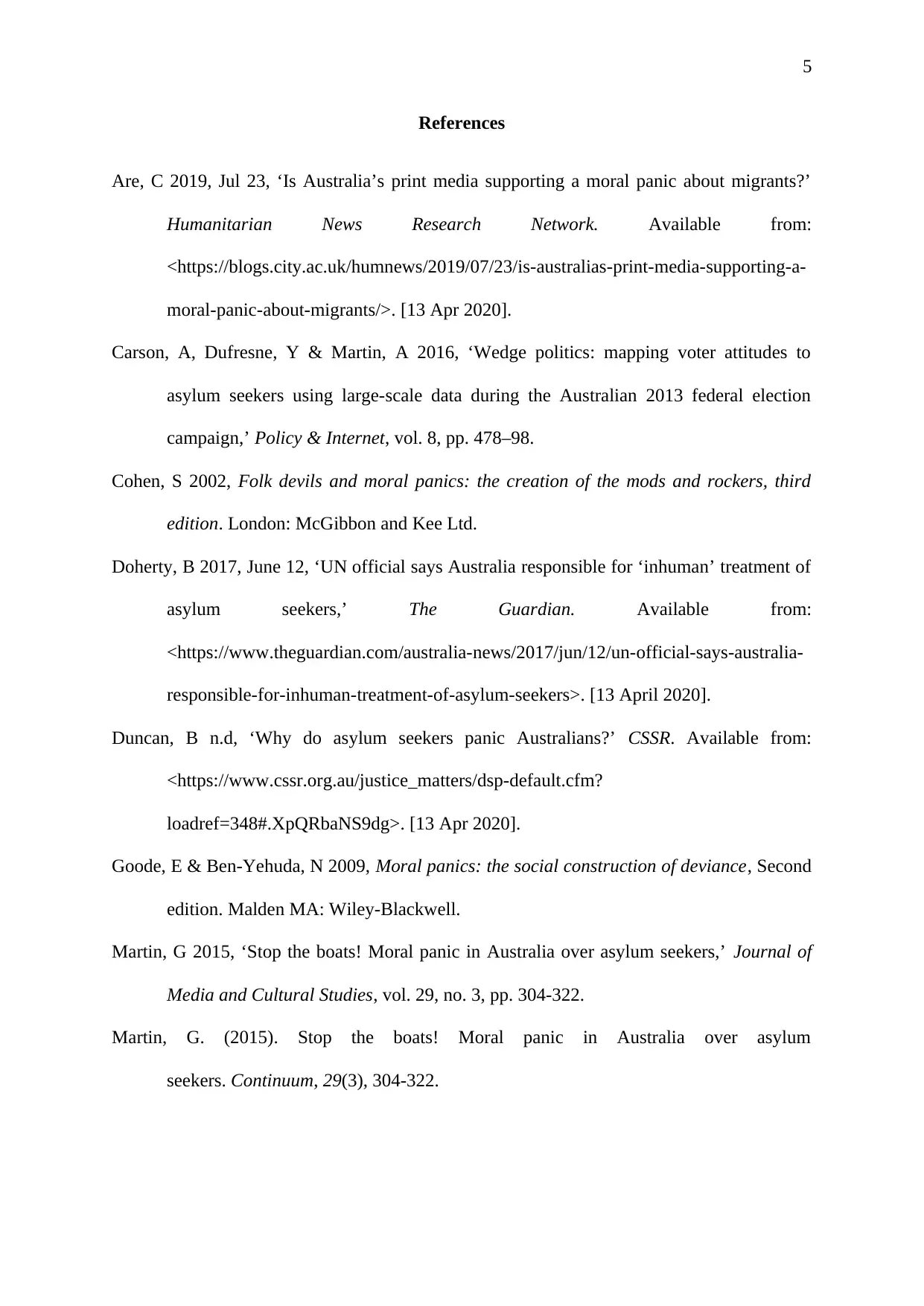
5
References
Are, C 2019, Jul 23, ‘Is Australia’s print media supporting a moral panic about migrants?’
Humanitarian News Research Network. Available from:
<https://blogs.city.ac.uk/humnews/2019/07/23/is-australias-print-media-supporting-a-
moral-panic-about-migrants/>. [13 Apr 2020].
Carson, A, Dufresne, Y & Martin, A 2016, ‘Wedge politics: mapping voter attitudes to
asylum seekers using large-scale data during the Australian 2013 federal election
campaign,’ Policy & Internet, vol. 8, pp. 478–98.
Cohen, S 2002, Folk devils and moral panics: the creation of the mods and rockers, third
edition. London: McGibbon and Kee Ltd.
Doherty, B 2017, June 12, ‘UN official says Australia responsible for ‘inhuman’ treatment of
asylum seekers,’ The Guardian. Available from:
<https://www.theguardian.com/australia-news/2017/jun/12/un-official-says-australia-
responsible-for-inhuman-treatment-of-asylum-seekers>. [13 April 2020].
Duncan, B n.d, ‘Why do asylum seekers panic Australians?’ CSSR. Available from:
<https://www.cssr.org.au/justice_matters/dsp-default.cfm?
loadref=348#.XpQRbaNS9dg>. [13 Apr 2020].
Goode, E & Ben-Yehuda, N 2009, Moral panics: the social construction of deviance, Second
edition. Malden MA: Wiley-Blackwell.
Martin, G 2015, ‘Stop the boats! Moral panic in Australia over asylum seekers,’ Journal of
Media and Cultural Studies, vol. 29, no. 3, pp. 304-322.
Martin, G. (2015). Stop the boats! Moral panic in Australia over asylum
seekers. Continuum, 29(3), 304-322.
References
Are, C 2019, Jul 23, ‘Is Australia’s print media supporting a moral panic about migrants?’
Humanitarian News Research Network. Available from:
<https://blogs.city.ac.uk/humnews/2019/07/23/is-australias-print-media-supporting-a-
moral-panic-about-migrants/>. [13 Apr 2020].
Carson, A, Dufresne, Y & Martin, A 2016, ‘Wedge politics: mapping voter attitudes to
asylum seekers using large-scale data during the Australian 2013 federal election
campaign,’ Policy & Internet, vol. 8, pp. 478–98.
Cohen, S 2002, Folk devils and moral panics: the creation of the mods and rockers, third
edition. London: McGibbon and Kee Ltd.
Doherty, B 2017, June 12, ‘UN official says Australia responsible for ‘inhuman’ treatment of
asylum seekers,’ The Guardian. Available from:
<https://www.theguardian.com/australia-news/2017/jun/12/un-official-says-australia-
responsible-for-inhuman-treatment-of-asylum-seekers>. [13 April 2020].
Duncan, B n.d, ‘Why do asylum seekers panic Australians?’ CSSR. Available from:
<https://www.cssr.org.au/justice_matters/dsp-default.cfm?
loadref=348#.XpQRbaNS9dg>. [13 Apr 2020].
Goode, E & Ben-Yehuda, N 2009, Moral panics: the social construction of deviance, Second
edition. Malden MA: Wiley-Blackwell.
Martin, G 2015, ‘Stop the boats! Moral panic in Australia over asylum seekers,’ Journal of
Media and Cultural Studies, vol. 29, no. 3, pp. 304-322.
Martin, G. (2015). Stop the boats! Moral panic in Australia over asylum
seekers. Continuum, 29(3), 304-322.
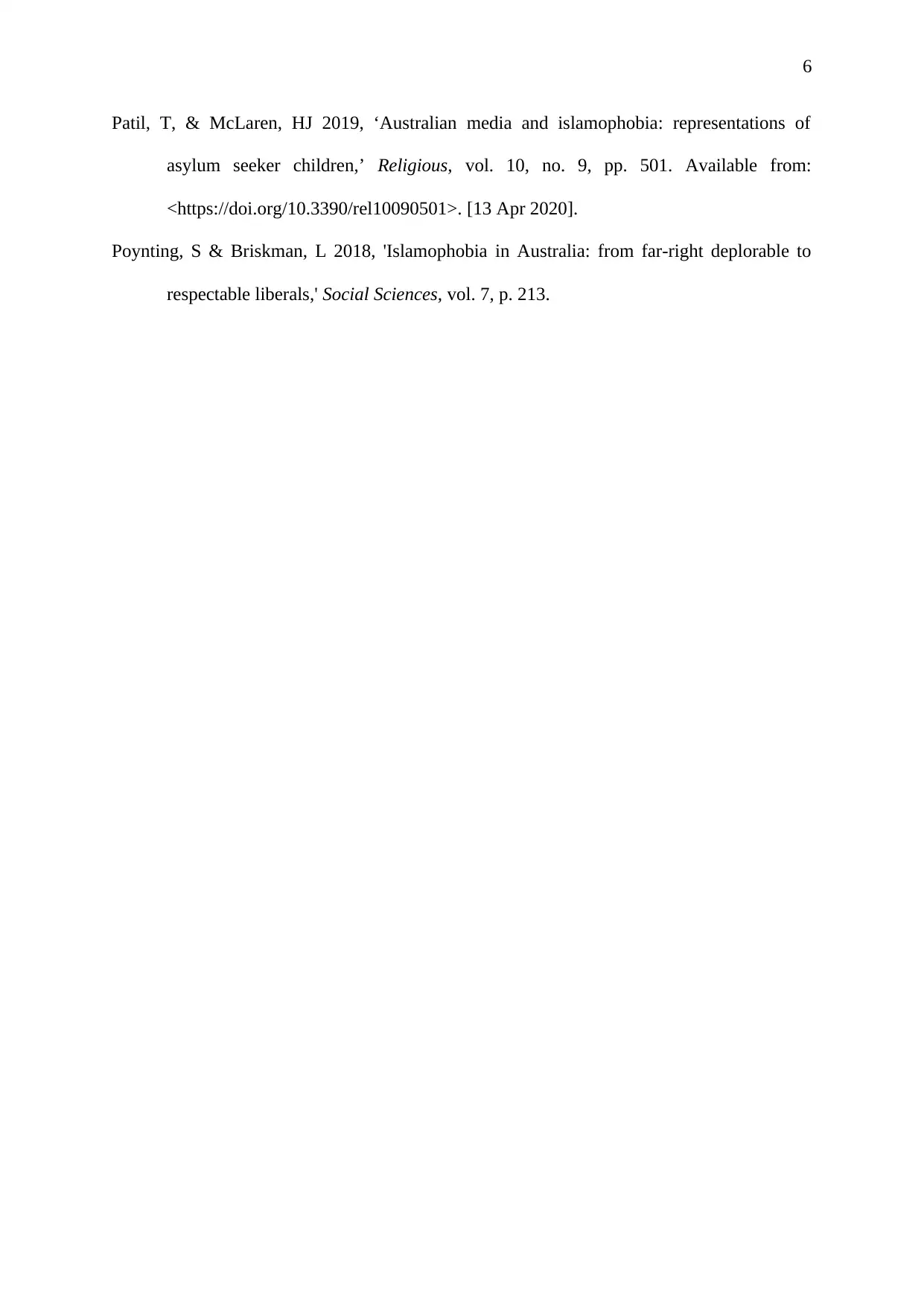
6
Patil, T, & McLaren, HJ 2019, ‘Australian media and islamophobia: representations of
asylum seeker children,’ Religious, vol. 10, no. 9, pp. 501. Available from:
<https://doi.org/10.3390/rel10090501>. [13 Apr 2020].
Poynting, S & Briskman, L 2018, 'Islamophobia in Australia: from far-right deplorable to
respectable liberals,' Social Sciences, vol. 7, p. 213.
Patil, T, & McLaren, HJ 2019, ‘Australian media and islamophobia: representations of
asylum seeker children,’ Religious, vol. 10, no. 9, pp. 501. Available from:
<https://doi.org/10.3390/rel10090501>. [13 Apr 2020].
Poynting, S & Briskman, L 2018, 'Islamophobia in Australia: from far-right deplorable to
respectable liberals,' Social Sciences, vol. 7, p. 213.
1 out of 7
Your All-in-One AI-Powered Toolkit for Academic Success.
+13062052269
info@desklib.com
Available 24*7 on WhatsApp / Email
![[object Object]](/_next/static/media/star-bottom.7253800d.svg)
Unlock your academic potential
© 2024 | Zucol Services PVT LTD | All rights reserved.